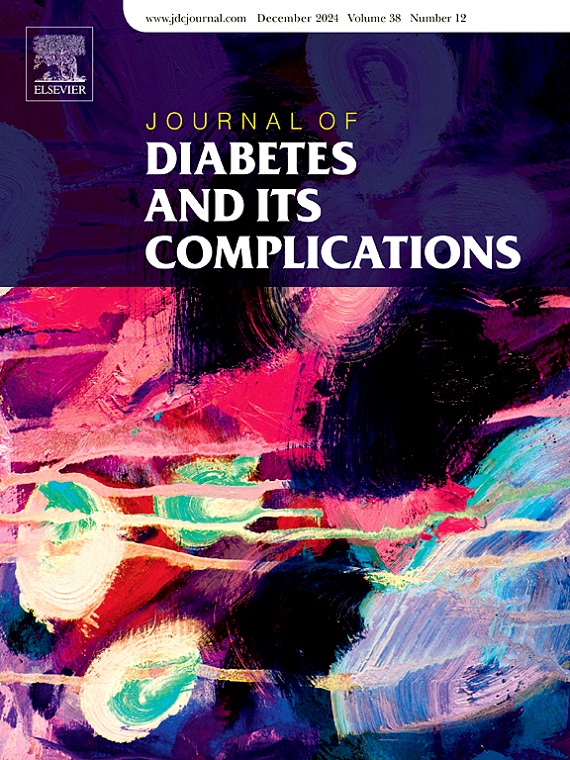2型糖尿病患者血流介导扩张与尿白蛋白-肌酐比值的关系
IF 3.1
3区 医学
Q3 ENDOCRINOLOGY & METABOLISM
引用次数: 0
摘要
目的探讨2型糖尿病(T2DM)患者血流介导的舒张(FMD)与尿白蛋白与肌酐比值(UACR)之间的关系。方法本横断面研究纳入194例诊断为T2DM的患者。参与者根据UACR水平分为两组:糖尿病肾病组(DKD) (UACR≥30 mg/g)和非糖尿病肾病组(非DKD) (UACR≤30 mg/g)。通过Spearman相关分析和多变量logistic回归分析评价口蹄疫与UACR的关系。此外,利用受试者工作特征曲线分析确定FMD对DKD的预测能力。结果DKD组FMD中位数低于非DKD组(3.9 vs 4.9, p = 0.011)。此外,FMD与UACR呈显著负相关(r = - 0.253, p < 0.05)。通过logistic回归分析,FMD每增加一个标准差(SD), UACR升高的可能性降低35.6% (OR: 0.644[0.459-0.904])(模型1)。即使在考虑了性别、年龄、BMI、高血压、吸烟习惯和酒精摄入量(模型2)以及HbA1c水平、疾病持续时间和甘油三酯(模型3)等变量后,也注意到一致的结果。口蹄疫的ROC曲线下面积(AUC)为0.686 (95% CI 0.596 ~ 0.777)。结论sfmd与UACR独立相关,为预防和控制早期DKD血管并发症提供了临床依据。本文章由计算机程序翻译,如有差异,请以英文原文为准。
Relationship between flow-mediated dilation and urinary albumin-creatinine ratio in patients with type 2 diabetes mellitus
Aims
To investigate the association between Flow-Mediated Dilation (FMD) and the urinary albumin-to-creatinine ratio (UACR) in individuals with type 2 diabetes mellitus (T2DM).
Methods
This cross-sectional study involved 194 individuals diagnosed with T2DM. Participants were categorized into two groups based on their UACR levels: the diabetic kidney disease group (DKD) (UACR≥30 mg/g) and the non-diabetic kidney disease group (non-DKD) (UACR <30 mg/g). The relationship between FMD and UACR was evaluated through Spearman correlation analysis and multivariable logistic regression analysis. Additionally, the predictive capacity of FMD for DKD was determined using receiver operating characteristic curve analysis.
Results
Median FMD was lower in DKD group than in non-DKD group (3.9 vs 4.9, p = 0.011). Furthermore, a notable negative correlation was observed between FMD and UACR (r = −0.253, p < 0.05). Through logistic regression analysis, an increase in FMD by one standard deviation (SD) corresponded to a 35.6 % decrease in the likelihood of elevated UACR (OR: 0.644 [0.459–0.904]) (Model 1). Consistent findings were noted even after accounting for variables such as sex, age, BMI, hypertension, smoking habits, and alcohol intake (Model 2), as well as HbA1c levels, disease duration, and triglycerides (Model 3). The area under the ROC curve (AUC) for FMD was 0.686 (95 % CI 0.596–0.777).
Conclusions
FMD is independently correlated with UACR, which provides a clinical basis for the prevention and control of vascular complications in early DKD.
求助全文
通过发布文献求助,成功后即可免费获取论文全文。
去求助
来源期刊

Journal of diabetes and its complications
医学-内分泌学与代谢
CiteScore
5.90
自引率
3.30%
发文量
153
审稿时长
16 days
期刊介绍:
Journal of Diabetes and Its Complications (JDC) is a journal for health care practitioners and researchers, that publishes original research about the pathogenesis, diagnosis and management of diabetes mellitus and its complications. JDC also publishes articles on physiological and molecular aspects of glucose homeostasis.
The primary purpose of JDC is to act as a source of information usable by diabetes practitioners and researchers to increase their knowledge about mechanisms of diabetes and complications development, and promote better management of people with diabetes who are at risk for those complications.
Manuscripts submitted to JDC can report any aspect of basic, translational or clinical research as well as epidemiology. Topics can range broadly from early prediabetes to late-stage complicated diabetes. Topics relevant to basic/translational reports include pancreatic islet dysfunction and insulin resistance, altered adipose tissue function in diabetes, altered neuronal control of glucose homeostasis and mechanisms of drug action. Topics relevant to diabetic complications include diabetic retinopathy, neuropathy and nephropathy; peripheral vascular disease and coronary heart disease; gastrointestinal disorders, renal failure and impotence; and hypertension and hyperlipidemia.
 求助内容:
求助内容: 应助结果提醒方式:
应助结果提醒方式:


